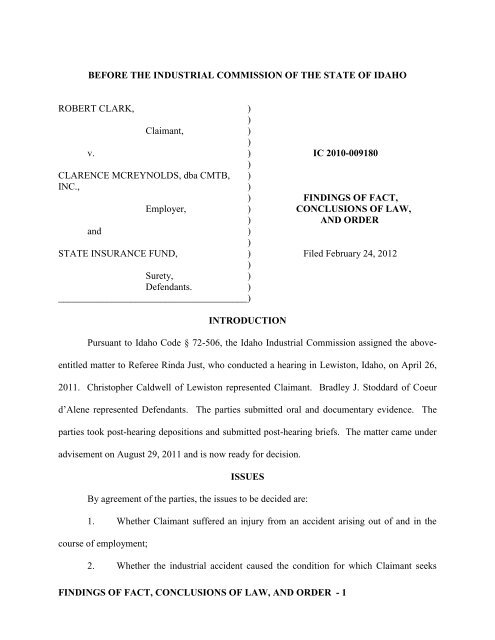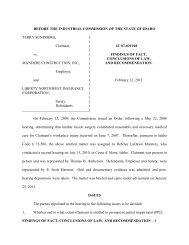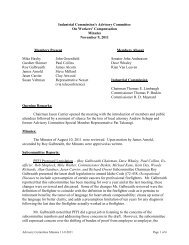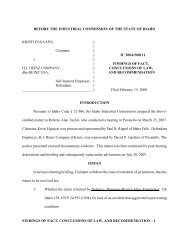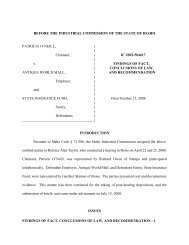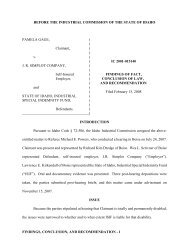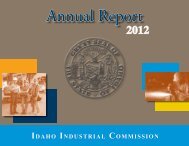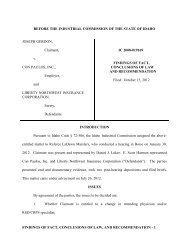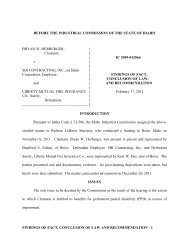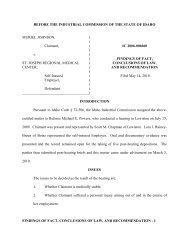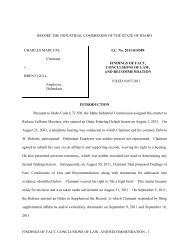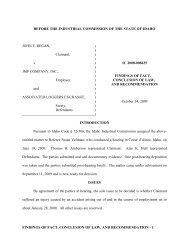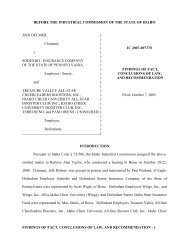Clark v. Clarence McReynolds, dba CMTB, Inc. - the Idaho Industrial ...
Clark v. Clarence McReynolds, dba CMTB, Inc. - the Idaho Industrial ...
Clark v. Clarence McReynolds, dba CMTB, Inc. - the Idaho Industrial ...
You also want an ePaper? Increase the reach of your titles
YUMPU automatically turns print PDFs into web optimized ePapers that Google loves.
BEFORE THE INDUSTRIAL COMMISSION OF THE STATE OF IDAHO<br />
ROBERT CLARK, )<br />
)<br />
Claimant, )<br />
)<br />
v. ) IC 2010-009180<br />
)<br />
CLARENCE MCREYNOLDS, <strong>dba</strong> <strong>CMTB</strong>, )<br />
INC., )<br />
) FINDINGS OF FACT,<br />
Employer, ) CONCLUSIONS OF LAW,<br />
) AND ORDER<br />
and )<br />
)<br />
STATE INSURANCE FUND, ) Filed February 24, 2012<br />
)<br />
Surety, )<br />
Defendants. )<br />
_______________________________________)<br />
INTRODUCTION<br />
Pursuant to <strong>Idaho</strong> Code § 72-506, <strong>the</strong> <strong>Idaho</strong> <strong>Industrial</strong> Commission assigned <strong>the</strong> aboveentitled<br />
matter to Referee Rinda Just, who conducted a hearing in Lewiston, <strong>Idaho</strong>, on April 26,<br />
2011. Christopher Caldwell of Lewiston represented Claimant. Bradley J. Stoddard of Coeur<br />
d‘Alene represented Defendants. The parties submitted oral and documentary evidence. The<br />
parties took post-hearing depositions and submitted post-hearing briefs. The matter came under<br />
advisement on August 29, 2011 and is now ready for decision.<br />
ISSUES<br />
By agreement of <strong>the</strong> parties, <strong>the</strong> issues to be decided are:<br />
1. Whe<strong>the</strong>r Claimant suffered an injury from an accident arising out of and in <strong>the</strong><br />
course of employment;<br />
2. Whe<strong>the</strong>r <strong>the</strong> industrial accident caused <strong>the</strong> condition for which Claimant seeks<br />
FINDINGS OF FACT, CONCLUSIONS OF LAW, AND ORDER - 1
enefits;<br />
3. Whe<strong>the</strong>r Claimant‘s condition is due in whole or in part to a pre-existing or<br />
subsequent injury or condition;<br />
4. Whe<strong>the</strong>r and to what extent Claimant is entitled to <strong>the</strong> following benefits:<br />
A. Medical care; and<br />
B. Temporary partial and/or temporary total disability benefits (TPD/TTD).<br />
All remaining issues, including permanent partial impairment (PPI), permanent disability<br />
in excess of impairment (PPD), whe<strong>the</strong>r Claimant is totally and permanently disabled as an oddlot<br />
worker, and <strong>the</strong> matter of attorney fees are reserved pending resolution of preliminary<br />
compensability issues.<br />
CONTENTIONS OF THE PARTIES<br />
Claimant asserts that on April 6, 2010 he injured his low back while working in Alaska<br />
on a trail-building project for Employer. While Claimant admits to having a history of low back<br />
problems, he avers that he was asymptomatic for <strong>the</strong> five years immediately preceding his 2010<br />
industrial accident, but now suffers constant pain and needs surgical intervention. Fur<strong>the</strong>r,<br />
Claimant asserts that he is entitled to income benefits during <strong>the</strong> period that he was off work due<br />
to his industrial injury.<br />
Defendants dispute that Claimant suffered an injury in an industrial accident while<br />
working in Alaska but, if he did, it was nothing more than a lumbar strain, and Claimant returned<br />
to his time-of-injury condition within two weeks. Employer offered light-duty work following<br />
<strong>the</strong> alleged injury; Claimant declined and is not entitled to income benefits. Finally, Claimant<br />
has a long history of low back problems, including two prior surgeries; however, his condition<br />
did not change following his alleged accident, and Defendants are not responsible for medical<br />
FINDINGS OF FACT, CONCLUSIONS OF LAW, AND ORDER - 2
enefits for repair of a prior fusion that failed.<br />
EVIDENCE CONSIDERED<br />
The record in this matter consists of <strong>the</strong> following:<br />
1. The testimony of Claimant, William Brown, Richard Brust, Thomas Gonzalez,<br />
and <strong>Clarence</strong> <strong>McReynolds</strong>, taken at hearing;<br />
2. The pre-hearing depositions of Rance Moore, taken April 13, 2011, and Jeff Scott,<br />
taken April 15, 2011 in lieu of appearance at <strong>the</strong> hearing;<br />
3. Claimant‘s Exhibits 1 through 6, admitted at hearing;<br />
4. Defendants‘ Exhibits A through W, admitted at hearing; and<br />
5. The post-hearing deposition of Jeffrey J. Larson, M.D., taken May 26, 2011.<br />
The undersigned Commissioners have chosen not to adopt <strong>the</strong> Referee‘s recommendation<br />
and hereby issue <strong>the</strong>ir own findings of fact, conclusions of law and order.<br />
FINDINGS OF FACT<br />
BACKGROUND<br />
1. Claimant was forty-four years of age at <strong>the</strong> time of hearing. He lived with his<br />
girlfriend, Dina Smith, in Whitebird, <strong>Idaho</strong>.<br />
2. Claimant obtained his high school diploma in Washington state, where he spent<br />
most of his life before moving to <strong>Idaho</strong> in 2008. Claimant worked primarily in <strong>the</strong> construction<br />
trades, including new residential construction, framing, siding, roofing, and construction<br />
management. Claimant briefly participated in a re-training program designed to improve his<br />
computer skills, but dropped out when he got a job as a construction superintendent.<br />
3. Claimant did not work for significant periods of time in <strong>the</strong> years preceding his<br />
2010 employment with Employer. He was off for two-and-a-half years following an industrial<br />
FINDINGS OF FACT, CONCLUSIONS OF LAW, AND ORDER - 3
injury in Washington in 2003. Claimant was laid off from his last full-time construction job in<br />
<strong>the</strong> fall of 2008 due to <strong>the</strong> collapse of <strong>the</strong> residential housing market. Following his move to<br />
Whitebird, Claimant did a few small project-type construction jobs (re-roofing, minor<br />
remodeling), but he did not have full-time employment until he went to work for Employer in<br />
March 2010.<br />
EMPLOYER<br />
4. <strong>Clarence</strong> <strong>McReynolds</strong> is <strong>the</strong> owner of <strong>CMTB</strong>, <strong>Inc</strong>.—<strong>Clarence</strong> <strong>McReynolds</strong> Trail<br />
Builder—and several o<strong>the</strong>r businesses, including a café and motel located near Whitebird.<br />
CMBT contracts throughout <strong>the</strong> western United States building trails on public lands. In 2010,<br />
CMBT was working primarily in Washington and Alaska.<br />
THE JOB<br />
5. In March 2010, Mr. <strong>McReynolds</strong> took a crew of five men, including Claimant, to<br />
a primitive base camp in a remote part of Prince of Wales Island, Alaska, near where CMBT had<br />
a contract to rebuild <strong>the</strong> One Duck Trail. 1<br />
The camp was about two miles from <strong>the</strong> staging area<br />
for <strong>the</strong> construction project, and about twenty miles from <strong>the</strong> nearest small town. The camp<br />
consisted of three ocean-going cargo containers connected by a beam and tarp roof; nei<strong>the</strong>r<br />
running water nor shower facilities were included among <strong>the</strong> living amenities.<br />
6. Wea<strong>the</strong>r conditions in Alaska in <strong>the</strong> early spring are inclement; it was constantly<br />
wet and bitterly cold. The crew worked eight hours a day, six-and-a-half days a week, in slick<br />
and muddy conditions, performing very heavy labor in steep, wooded terrain. Once a week,<br />
Employer gave <strong>the</strong> crew a half day to go into town, shower, and do laundry.<br />
1 The crew consisted of foreman Thomas Gonzales, his two bro<strong>the</strong>rs David and Jose, Claimant,<br />
and Mr. <strong>McReynolds</strong>‘ grandson, Charlie Hickman.<br />
FINDINGS OF FACT, CONCLUSIONS OF LAW, AND ORDER - 4
7. The One Duck Trail was approximately one and a quarter miles long. It took a<br />
crew of four men forty-five days to complete <strong>the</strong> work. A good day‘s progress consisted of one<br />
hundred to one hundred fifty feet of trail. The project included demolition of old trail structures<br />
(bridges and cedar corduroy), clearing brush and trees, installing water bars and new corduroy,<br />
and laying <strong>the</strong> new trail materials. The job involved very heavy work under adverse conditions.<br />
8. Mr. <strong>McReynolds</strong> spent about two weeks with <strong>the</strong> crew getting things set up and<br />
getting <strong>the</strong> work started. Once <strong>the</strong> project was underway, he left his foreman, Thomas Gonzales,<br />
in charge of <strong>the</strong> crew, and returned to Whitebird, arriving home on April 6.<br />
THE ACCIDENT<br />
9. On <strong>the</strong> morning of April 6, 2010, <strong>the</strong> trail cat (a piece of equipment resembling a<br />
small excavator/backhoe used in building trail) was awaiting repair. Thomas Gonzales directed<br />
Claimant and Charlie Hickman to remove old trail timbers 2 by hand while he went to town to<br />
pick up <strong>the</strong> part for <strong>the</strong> trail cat. Sometime around 10:30 or 11:00 a.m., Thomas returned to<br />
where Charlie and Claimant were working, told Charlie <strong>the</strong> trail cat was up and running, and<br />
directed him back down <strong>the</strong> trail to run <strong>the</strong> equipment. Thomas directed Claimant to continue<br />
working on <strong>the</strong> demolition.<br />
10. Claimant told Thomas that it was particularly difficult to get <strong>the</strong> old boards loose<br />
and suggested it would be much faster to pop <strong>the</strong>m up using <strong>the</strong> bucket of <strong>the</strong> trail cat, but<br />
Thomas told him to keep doing what he had been doing.<br />
11. Shortly after Charlie left, Claimant popped one end of a timber off <strong>the</strong> spike on<br />
one end of <strong>the</strong> support structure and was pushing <strong>the</strong> timber up and away so <strong>the</strong> o<strong>the</strong>r side of <strong>the</strong><br />
2 Think of a deck, but constructed with sawed half logs fastened on top of cross-timbers with<br />
long spikes to create a stable and flat walking surface.<br />
FINDINGS OF FACT, CONCLUSIONS OF LAW, AND ORDER - 5
timber would come loose. Claimant stated:<br />
Well, when I was pushing one of <strong>the</strong> logs up and away from me, it was a real<br />
stubborn one and it – I just felt a pop in my low back and just pop, and it shot pain<br />
down both my legs and just about dropped me to my knees.<br />
Tr., p. 71. Claimant walked down <strong>the</strong> trail toward <strong>the</strong> staging area where <strong>the</strong> rest of <strong>the</strong> crew<br />
was working. When he saw Mr. Gonzalez, Claimant told him that he had hurt his back.<br />
Claimant specifically recalled that Mr. Gonzalez asked whe<strong>the</strong>r Claimant needed medical care,<br />
to which Claimant replied, ―Not right now. Let‘s just see how I do. I‘m going to go sit in <strong>the</strong><br />
truck. You guys just keep working, and I‘m just going to go sit down for a while and turn <strong>the</strong><br />
heat on . . .‖ Id., at p. 75.<br />
12. Claimant spent <strong>the</strong> rest of <strong>the</strong> day sitting in <strong>the</strong> truck with <strong>the</strong> heater on. Over <strong>the</strong><br />
course of <strong>the</strong> afternoon he had a conversation with a forest service employee and Mr. Gonzalez<br />
or o<strong>the</strong>r members of <strong>the</strong> crew checked on him periodically. When <strong>the</strong> crew was done for <strong>the</strong><br />
day, <strong>the</strong>y all returned to <strong>the</strong>ir camp for <strong>the</strong> evening. Claimant remained in <strong>the</strong> truck because he<br />
was ―freezing‖ and it took a long time for <strong>the</strong> cargo containers to warm up. Later that evening<br />
Claimant asked Mr. Gonzalez to take him to town. He explained:<br />
I just needed somewhere more comfortable to stay. I wanted to soak in a hot<br />
bathtub and just be, you know – I don‘t have a vehicle up <strong>the</strong>re anyway to go<br />
anywhere, so I thought it was best just to go stay <strong>the</strong> night in a motel and see how<br />
I did.<br />
Id., at p. 78. Mr. Gonzalez took Claimant to town and paid for two nights at <strong>the</strong> motel.<br />
13. Claimant‘s pain ―got worse as <strong>the</strong> night went on. I couldn‘t sleep. I had pain that<br />
wouldn‘t stop down my legs, so I knew something was badly wrong . . .‖ Id., p. 79. The<br />
following morning, Claimant took a taxi to <strong>the</strong> local medical center:<br />
I told [<strong>the</strong> treater] exactly how I did <strong>the</strong> injury, removing <strong>the</strong> log step, pushing<br />
away from me, and I told him that it feels like my fusion broke. That‘s exactly<br />
what it felt like. It felt like – I had a fusion in ‘04 and it just – I thought it broke.<br />
FINDINGS OF FACT, CONCLUSIONS OF LAW, AND ORDER - 6
Id., at p. 80. After Claimant returned from <strong>the</strong> clinic, Mr. Gonzalez arrived with <strong>the</strong> rest of <strong>the</strong><br />
crew, and used Claimant‘s motel room to get showers. Mr. Gonzalez asked Claimant what he<br />
wanted to do, offering to let him return to <strong>the</strong> camp doing light-duty work (cooking, dishes, etc.).<br />
Claimant said he wanted to return to <strong>Idaho</strong>.<br />
14. Employer made arrangements and paid for Claimant to return to Whitebird, which<br />
took a couple of days due to wea<strong>the</strong>r. After returning home, Claimant did not return to work for<br />
Employer, nor did he seek o<strong>the</strong>r work.<br />
PRIOR MEDICAL HISTORY<br />
15. The medical record in this proceeding establishes that Claimant was having back<br />
problems as early as <strong>the</strong> mid-1990s, when he was in his late twenties. In <strong>the</strong> fall of 1998,<br />
Claimant sought care for his back, complaining of low back pain for <strong>the</strong> past two years.<br />
Radiographic images from August 1998 show grade one spondylolis<strong>the</strong>sis of L5 on S1, toge<strong>the</strong>r<br />
with mild degenerative changes, especially at L2-3.<br />
16. Claimant received conservative care, including chiropractic, and a physical<br />
<strong>the</strong>rapy evaluation, but did not follow through with <strong>the</strong> recommended physical <strong>the</strong>rapy.<br />
17. In early February 1999, Claimant presented with complaints of extreme low back<br />
pain. He told <strong>the</strong> treating physician that physical <strong>the</strong>rapy had not helped his pain in <strong>the</strong> past, and<br />
that he had two visits with a chiropractor without relief. A steroid injection provided only<br />
minimal relief.<br />
18. In March 1999, Claimant underwent a CT scan of his lumbar spine, which<br />
showed grade one spondylolis<strong>the</strong>sis L5 on S1, and spondylolysis at L5, and a large disc<br />
protrusion on <strong>the</strong> right filling <strong>the</strong> neural foramen.<br />
FINDINGS OF FACT, CONCLUSIONS OF LAW, AND ORDER - 7
19. Claimant‘s treating physician referred Claimant to an orthopedist (Richard<br />
Atwater, M.D.) for a surgical consult. Dr. Atwater took a history, reviewed radiographic images,<br />
and performed a physical. Dr. Atwater concluded that Claimant‘s history and physical did not<br />
correspond with his radiographic findings. Dr. Atwater did not believe that Claimant was a<br />
surgical candidate, but ordered a bone scan to rule out facet joint involvement, and ordered<br />
physical <strong>the</strong>rapy. Four days later, Claimant‘s girlfriend called Dr. Atwater and declared that<br />
Claimant did not want physical <strong>the</strong>rapy; he wanted surgery to fix his back. The bone scan, done<br />
a few days later, was negative. Dr. Atwater noted that Claimant‘s spondylolis<strong>the</strong>sis had existed<br />
for some time. He recommended a dramatic reduction in Claimant‘s activity level for ten days to<br />
two weeks, and referred Claimant to ano<strong>the</strong>r orthopedist for a second opinion.<br />
20. Claimant reported new pain complaints in late May 1999, and an MRI was<br />
ordered. It showed no change from previous radiographic images. In late June, Claimant saw<br />
Dr. Nussbaum, an orthopedist, who recommended conservative treatment and referral to a<br />
physiatrist. He considered that an L5-S1 fusion was a fallback position, which would require<br />
Claimant to quit smoking for some time before surgery became an option.<br />
21. Claimant did not seek care for his back again until a year later, in April 2000. In<br />
<strong>the</strong> interim, he had continued working at his construction job, had not participated in physical<br />
<strong>the</strong>rapy, and was still using tobacco products. Flexion/extension x-rays showed that Claimant‘s<br />
lis<strong>the</strong>sis was stable on extension. Unfortunately, <strong>the</strong> flexion views were incomplete. The x-ray<br />
report described a grade two anterolis<strong>the</strong>sis of L5 on S1.<br />
22. In early May 2000, Claimant self-referred to Robert H. Cancro, M.D. Dr. Cancro<br />
reviewed <strong>the</strong> imaging and expressed some surprise that Claimant did not report more radicular<br />
symptoms in light of <strong>the</strong> large extrusion occluding <strong>the</strong> right L5-S1 foramen. Never<strong>the</strong>less,<br />
FINDINGS OF FACT, CONCLUSIONS OF LAW, AND ORDER - 8
Dr. Cancro recommended conservative care, including exercise <strong>the</strong>rapy.<br />
He opined that if<br />
Claimant‘s condition worsened, he would re-evaluate and consider surgical intervention by way<br />
of a Gill procedure. Just a few days after Claimant‘s first visit to Dr. Cancro, a chart note<br />
indicates that Claimant‘s wife called <strong>the</strong> office to report that Claimant wanted to proceed with<br />
<strong>the</strong> Gill procedure immediately. Pre-operative notes state that Claimant would be off work at<br />
least three months following <strong>the</strong> procedure.<br />
23. On May 30, 2000, Dr. Cancro performed a bilateral Gill wide decompressive<br />
laminectomy and resection of cartilaginous material in Claimant‘s disc. At his first and only<br />
post-operative visit (a week after <strong>the</strong> surgery), Claimant reported excellent relief of his right<br />
radicular pain. Claimant did not return for additional follow-up, and did not use <strong>the</strong> back brace<br />
that Dr. Cancro had prescribed. Claimant returned to his construction work six weeks after his<br />
surgery.<br />
24. By mid-December 2000, Claimant‘s right side radicular symptoms had returned,<br />
and Claimant was back in Dr. Cancro‘s office. On December 14, 2000, Dr. Cancro compared<br />
Claimant‘s new x-rays with prior imaging:<br />
Compared x-rays from yesterday, 12/13/2000 at VOA-Renton with CMC films of<br />
5/4/2000. This shows <strong>the</strong> identical Grade 1-2 chronic anterior lis<strong>the</strong>sis of L5 on<br />
S1 from spondylolytic pars. This <strong>the</strong>n compares a preoperative x-ray with <strong>the</strong><br />
present spine, indicating no laxity or slip as a result of <strong>the</strong> decompressive surgery.<br />
Fur<strong>the</strong>r investigation of nerve root encroachment needs to be performed with an<br />
MRI.<br />
D‘s Ex. H, p. 7.<br />
25. Claimant did not return to Dr. Cancro until <strong>the</strong> spring of 2002, at which time he<br />
complained of ―right greater than left low back pain with right buttock and right lateral leg pain,<br />
cramping lateral leg frequently with toes curling in flexion . . .‖ Id., at p. 11. Dr. Cancro ordered<br />
a lumbar spine MRI, which showed ―Grade 2 L5-S1 spondylolis<strong>the</strong>sis with mild to moderate<br />
FINDINGS OF FACT, CONCLUSIONS OF LAW, AND ORDER - 9
ilateral neural foraminal stenosis and potential impingement of L5 nerve root. There are milder<br />
degenerative changes present, L3-4 and L4-5.‖ Id. Dr. Cancro referred Claimant for a series of<br />
injections to <strong>the</strong> right L5 nerve root at L5-S1. Apparently, Claimant received one injection<br />
―which proved to be very beneficial in regards to <strong>the</strong> pain.‖ D‘s Ex. J, p. 1.<br />
26. More than a year later, in August 2003, Claimant presented at <strong>the</strong> offices of<br />
Chester Jangala, M.D., complaining of low back and right leg pain following an industrial injury.<br />
Dr. Jangala noted:<br />
Even through [Claimant] has a significant back injury history, I think it would be<br />
more logical to consider this a new injury ra<strong>the</strong>r than an exacerbation or natural<br />
progression of a pre-existing problem. There was a specific incident that resulted<br />
in a change in his objective status. If this injury involves <strong>the</strong> same area as his<br />
previous surgery, <strong>the</strong>n an aggravation to a pre-existing problem would need to be<br />
considered.<br />
Id., at p. 2. Dr. Jangala ordered a lumbar MRI and specifically asked <strong>the</strong> radiologist to compare<br />
<strong>the</strong> imaging with Claimant‘s two prior MRIs. The MRI report, dated August 14, 2003, was read<br />
as:<br />
1. Status post laminectomy, L5-S1, with grade 2 anterolis<strong>the</strong>sis of L5 on S1,<br />
resulting in bilateral neural foraminal narrowing with impingement of <strong>the</strong> exiting<br />
nerve roots.<br />
2. At L4-5 disk protrusion and facet disease result in mild narrowing of <strong>the</strong> spinal<br />
canal and narrowing of <strong>the</strong> inferior portion of <strong>the</strong> neural foramina bilaterally.<br />
Along with facet disease, this abuts <strong>the</strong> left exiting nerve root and may impinge it.<br />
This also abuts <strong>the</strong> right exiting nerve root at this level.<br />
Id. The report did not address <strong>the</strong> changes, if any, among and between Claimant‘s two prior<br />
MRIs and <strong>the</strong> instant imaging; however, from a lay perspective, <strong>the</strong> reports of <strong>the</strong>se studies<br />
appear to be nearly identical except for <strong>the</strong> intervening laminectomy. Claimant initially received<br />
conservative care for his 2003 industrial injury. In late September 2003, Dr. Jangala counseled<br />
him regarding medical options:<br />
FINDINGS OF FACT, CONCLUSIONS OF LAW, AND ORDER - 10
Id., at p. 7.<br />
I talked to [Claimant] in detail about this and told him that <strong>the</strong> only way to<br />
definitively try and fix his pain would be to do a lumbar fusion. However, this<br />
would involve him possibly not ever working again as a framer or even any type<br />
of work. There are definitely risks to <strong>the</strong> surgery and it should be considered as a<br />
measure of last resort. I think that he would prefer to change <strong>the</strong> type of work he<br />
does and institute <strong>the</strong> more conservative measures first.<br />
27. In mid-December 2003, Dr. Jangala provided an update to WLIS (Washington<br />
Labor and <strong>Industrial</strong> Services) stating that he had not been able to evaluate Claimant‘s condition<br />
because Claimant had not followed up on recommendations and referrals. Dr. Jangala also<br />
suggested that WLIS schedule Claimant for a work-hardening program and a physical capacity<br />
evaluation. Then, on January 5, 2004, Dr. Jangala took Claimant off work until <strong>the</strong> middle of<br />
March 2004. There is no related chart note to illuminate Dr. Jangala‘s thinking.<br />
28. On February 13, 2004, Claimant saw Ali J. Naini, M.D., for a neurosurgical<br />
consultation. Presenting complaints included right L5 radiculopathy, recurring. Claimant<br />
advised Dr. Naini of his previous low back problems, but told Dr. Naini that he had done very<br />
well postoperatively ―with no residual symptoms or problems aside from some occasional lower<br />
back pain‖ until his August 2003 industrial injury. D‘s. Ex. L, p. 3. Claimant told Dr. Naini that<br />
since his August 2003 industrial injury ―he has been unable to work and has undergone an<br />
extensive course of non-operative <strong>the</strong>rapy without success.<br />
There has been ‗really bad‘<br />
numbness/tingling that is present ‗95% of <strong>the</strong> time‘ in his Right lateral lower leg. . .‖ Id. On<br />
exam, Dr. Naini observed right L5 dermatomal numbness, but strength and reflexes were normal<br />
and symmetric bilaterally. Dr. Naini reviewed <strong>the</strong> August 14 MRI imaging and report, noting<br />
<strong>the</strong> grade two spondylolis<strong>the</strong>sis. Dr. Naini diagnosed a grade two L5-S1 spondylolis<strong>the</strong>sis ―with<br />
severe, debilitating pain as well as correlating neurological and MRI findings.‖ Id., at p. 5.<br />
Dr. Naini discussed Claimant‘s treatment options, and Claimant wanted to proceed with a<br />
FINDINGS OF FACT, CONCLUSIONS OF LAW, AND ORDER - 11
medical work-up with an aim toward surgery. Dr. Naini ordered flexion and extension x-rays<br />
and a three-dimensional CT of <strong>the</strong> lumbar spine.<br />
29. Claimant returned to Dr. Naini for follow up in early March 2004. Dr. Naini<br />
reviewed <strong>the</strong> CT scans, noting that <strong>the</strong>y showed a grade two L5-S1 spondylolis<strong>the</strong>sis with<br />
bilateral defects in <strong>the</strong> pars interarticularis. Flexion/extension x-rays showed no instability.<br />
Dr. Naini‘s chart note for <strong>the</strong> visit includes this assessment:<br />
Mr. <strong>Clark</strong> continues to experience severe, debilitating pain due to his overt L5-S1<br />
spondylolis<strong>the</strong>sis. He has failed a long course of non-operative <strong>the</strong>rapy and<br />
would like to proceed with surgery [L5-S1 fusion (PLIF) with pedicle screws] as<br />
soon as he has obtained approval from his insurer.<br />
Id., at p. 12. Claimant returned to Dr. Naini in late April 2004, and advised that he wanted to<br />
proceed with surgery for his low back. Dr. Naini discussed one non-operative option and five<br />
operative options with Claimant. Claimant opted to undergo L5-S1 laminectomy, decompression<br />
and posterior lumbar interbody fusion/pedicle screw fixation using bone bank donor bone as well<br />
as iliac crest bone grafting to <strong>the</strong> transverse process.<br />
30. Dr. Naini performed <strong>the</strong> surgery on June 3, 2004. Dr. Naini encountered ―an<br />
immense amount of firm, partially calcified scar tissue compressing <strong>the</strong> <strong>the</strong>cal sac from <strong>the</strong> lower<br />
border of <strong>the</strong> L4 lamina down to <strong>the</strong> S1 level.‖ Id., at p. 20. The fibrotic tissue was so dense,<br />
and so intractable, that Dr. Naini was unable to enter <strong>the</strong> disc space between L5 and S1 to<br />
perform <strong>the</strong> posterior lumbar interbody fusion and realignment that he had planned. Instead, he<br />
performed a decompressive laminectomy from <strong>the</strong> lower border of L4 to L5 and S1, a resection<br />
of compressive scar tissue and remaining portion of intraspinous facets at L5-S1, and bilateral<br />
foraminotomies, and transverse process fusions at L5-S1.<br />
31. Despite <strong>the</strong> difficulties encountered by Dr. Naini, he described Claimant‘s<br />
outcome as ―excellent, with a mechanically stable spine that should be reinforced with a fusion<br />
FINDINGS OF FACT, CONCLUSIONS OF LAW, AND ORDER - 12
in <strong>the</strong> future, and fully decompressed nerve roots as evidenced by complete resolution of <strong>the</strong><br />
patient‘s leg pain after surgery.‖ Id., at p. 24 (emphasis added). Claimant‘s post-operative<br />
course was complicated by alcohol withdrawal symptoms, which kept him hospitalized for six<br />
days. Upon discharge, Dr. Naini advised Claimant that he would need a lengthy recovery,<br />
including three months of light-duty. Dr. Naini also cautioned that Claimant should not return to<br />
<strong>the</strong> heavy lifting required of his former occupation ―because of <strong>the</strong> risks of recurrent injury to <strong>the</strong><br />
site of his Grade II spondylolis<strong>the</strong>sis.‖ Id., at p. 30.<br />
32. Claimant‘s first documented follow-up visit was in mid-July 2004, five-and-a-half<br />
weeks after his surgery. Claimant stated that he had no leg pain and that his low back pain was<br />
resolving.<br />
Dr. Naini concluded that Claimant had an excellent operative outcome and he<br />
expected Claimant to continue to do well in <strong>the</strong> future.<br />
Dr. Naini specifically cautioned<br />
Claimant regarding his activities. Claimant did not return for additional follow-up care with<br />
Dr. Naini. When WLIS contacted Dr. Naini in December 2004 regarding Claimant‘s condition,<br />
he noted in response: ―Sorry, but I have not seen [Claimant] for over 4 months and am not<br />
presently treating him.‖ Id., at p. 32.<br />
33. In September 2004, Claimant began treating with Kyle Oh, M.D., of Kirkland<br />
Spine Care—evidently on a referral from Dr. Naini, though <strong>the</strong>re is no record of <strong>the</strong> referral in<br />
Dr. Naini‘s files. Dr. Oh sent Claimant to physical <strong>the</strong>rapy, though according to <strong>the</strong> hearing<br />
record Claimant only attended four physical <strong>the</strong>rapy sessions from September 29 through<br />
October 7, 2004. Dr. Oh followed Claimant monthly through December, extending his physical<br />
<strong>the</strong>rapy orders in October and November, though <strong>the</strong>re is no evidence that Claimant continued<br />
receiving physical <strong>the</strong>rapy.<br />
Dr. Oh also acted as a liaison between Claimant and WLIS<br />
vocational consultants. Dr. Oh consistently reported to <strong>the</strong> vocational consultants that Claimant<br />
FINDINGS OF FACT, CONCLUSIONS OF LAW, AND ORDER - 13
had permanent light-duty work restrictions. In mid-December 2004, Claimant told Dr. Oh that<br />
he did not wish to continue with physical <strong>the</strong>rapy. Dr. Oh advised Claimant that if he did not<br />
want to reinjure his back, he needed to continue to streng<strong>the</strong>n his muscles. Dr. Oh discharged<br />
Claimant from physical <strong>the</strong>rapy, but strongly encouraged him to keep up with his home exercise<br />
program.<br />
34. Dr. Oh prepared his closing report on Claimant‘s industrial injury on January 12,<br />
2005. He reported to WLIS that Claimant was medically fixed and stable from his industrial<br />
injury. Dr. Oh gave Claimant a partial permanent disability rating, noting:<br />
Patient did have a non-work related low back injury in 2000, at which time he did<br />
undergo a lumbar laminectomy. However, patient recovered from this injury<br />
completely and was able to return to his regular job in construction/carpentry<br />
without any significant problems until he injured his low back at work on<br />
8/2/2003. Therefore, this should not be considered a pre-existing condition, and<br />
patient should be given <strong>the</strong> full Category IV rating.<br />
D‘s. Ex. N, p. 21 (emphasis added). Dr. Oh also noted that Claimant should not return to<br />
construction work and would have a permanent light-duty work restriction.<br />
35. Claimant returned to Dr. Oh in late September 2005, with complaints of<br />
worsening low back pain. He advised Dr. Oh that he had dropped out of his vocational training<br />
program and taken a job as a construction superintendent, but after three weeks of work,<br />
Claimant‘s low back symptoms got worse. Dr. Oh started <strong>the</strong> process for Claimant to re-open<br />
his WLIS claim. On October 6, 2005, Claimant filed his application to reopen his claim in which<br />
he stated that he was unable to work because of low back pain and stiffness. Claimant withdrew<br />
his request in early November 2005 when he got a job as a construction manager for Norris<br />
Homes.<br />
FINDINGS OF FACT, CONCLUSIONS OF LAW, AND ORDER - 14
CLAIMANT’S CONDITION PRIOR TO APRIL 2010<br />
36. It does not appear that Claimant sought treatment for his low back complaints<br />
from November 2005 until <strong>the</strong> spring of 2010. Claimant did, however, continue to complain<br />
about low back pain, at least after moving to Whitebird in 2008. Dick Brust, a friend and<br />
neighbor of Claimant, learned in <strong>the</strong> summer of 2009 about Claimant‘s back problems. While<br />
doing some work for Mr. Brust, Claimant told him that his back hurt and that ―he had an<br />
operation on it but it didn‘t do any good.‖ Tr., p. 25. Rance Moore, a retired law enforcement<br />
officer who lives in Whitebird, is acquainted with Claimant, and considers him a friend.<br />
Mr. Moore himself has back problems, was aware of Claimant‘s back complaints, and<br />
occasionally asked Claimant how his back was doing, to which Claimant generally responded<br />
that his back bo<strong>the</strong>red him. While cutting and drilling timbers for bridge construction in Alaska,<br />
Claimant told Mr. Gonzalez about his prior back injuries. Claimant also complained about <strong>the</strong><br />
problems he was having with his back to Charlie Hollifield, who cautioned his grandfa<strong>the</strong>r<br />
(Employer in this proceeding) about taking Claimant on <strong>the</strong> Alaska project. Employer was also<br />
aware of Claimant‘s back problems through conversations with Claimant‘s girlfriend, who<br />
worked for Employer in <strong>the</strong> café.<br />
37. Once Claimant began working in Alaska, he complained daily about his low back<br />
to Mr. Gonzalez and o<strong>the</strong>r members of <strong>the</strong> crew. Mr. Gonzalez observed that Claimant ―don‘t<br />
want to do that kind of job,‖ and he did not expect Claimant to ―last very long here.‖ Id., p. 163.<br />
POST-INJURY MEDICAL CARE<br />
38. Claimant first sought care for his April 2010 back injury at <strong>the</strong> SouthEast Alaska<br />
Regional Health Consortium, where he presented on April 7, 2010 complaining of pain going<br />
down both legs to <strong>the</strong> toes. Lumbar x-rays showed a grade two spondylolis<strong>the</strong>sis at L5 on S1<br />
FINDINGS OF FACT, CONCLUSIONS OF LAW, AND ORDER - 15
with bilateral facet joint hypertrophy at <strong>the</strong> L5-S1 level, worse on <strong>the</strong> right. Claimant left <strong>the</strong><br />
clinic with Tylenol 3 for pain relief.<br />
Dr. Griffis<br />
39. Back in Whitebird, Claimant sought care from Syringa Hospital and Clinics,<br />
where he saw Danny Griffis, M.D, on April 12. Dr. Griffis made two objective findings on<br />
exam—mild tenderness to palpation over <strong>the</strong> left lateral lower lumbar spine to S1, and a positive<br />
right side straight-leg raise. Dr. Griffis sent Claimant for a physical <strong>the</strong>rapy evaluation, with reevaluation<br />
in two weeks. Dr. Griffis released Claimant to light-duty work effective April 19.<br />
40. Claimant attended <strong>the</strong> physical <strong>the</strong>rapy evaluation on April 15 and two <strong>the</strong>rapy<br />
sessions before he returned to see Dr. Griffis on April 20. Claimant reported improvement in his<br />
symptoms, and Dr. Griffis found no tenderness on palpation. In <strong>the</strong> interim, Dr. Griffis obtained<br />
and reviewed <strong>the</strong> x-rays taken in Alaska. Dr. Griffis continued Claimant‘s physical <strong>the</strong>rapy and<br />
his light-duty work restrictions.<br />
41. On May 3, 2010, Claimant called Dr. Griffis‘ office complaining that his<br />
symptoms were getting worse with physical <strong>the</strong>rapy, stating ―I know something is wrong.‖ D‘s<br />
Ex. Q, p. 8. Dr. Griffis ordered an MRI. On May 13, Dr. Griffis wrote a letter ―To whom it may<br />
concern,‖ stating that he learned that Surety denied <strong>the</strong> MRI he had ordered ―because <strong>the</strong>re was<br />
no accident.‖ Id., at p. 9. Dr. Griffis noted that such a finding was contrary to <strong>the</strong> history<br />
provided by Claimant, observed that conservative treatment was not effective, and opined that<br />
<strong>the</strong> MRI was necessary to evaluate Claimant‘s injury.<br />
42. A week later, on May 20, Claimant had a lumbar MRI showing:<br />
L4-5: There is a slight retrolis<strong>the</strong>sis of L4 and L5 with loss of disc height. There<br />
is a circumferential disc bulge superimposed upon bilateral facet arthrosis and<br />
ligamentum flavum redundancy. Posteriorly disc bulging impinges approximately<br />
5 mm upon <strong>the</strong> central spinal canal where it is superimposed upon bilateral facet<br />
FINDINGS OF FACT, CONCLUSIONS OF LAW, AND ORDER - 16
arthrosis. There is no <strong>the</strong>cal sac narrowing. There is significant right neural<br />
foraminal narrowing with impingement of <strong>the</strong> exiting right L5 nerve root. There<br />
is moderate left neural foraminal narrowing with impingement of <strong>the</strong> exiting left<br />
L5 nerve root.<br />
L5-S1: There is an approximately 11 mm anterolis<strong>the</strong>sis of L5 on S1. This<br />
contributes to <strong>the</strong> formation of a posterior 9 mm disc bulge superimposed upon<br />
bilateral facet arthrosis. This does not impinge <strong>the</strong> decompressed <strong>the</strong>cal sac.<br />
There is very significant right neural foraminal narrowing with impingement of<br />
<strong>the</strong> exiting right L5 nerve root. There is significant left neural foraminal<br />
narrowing with impingement of <strong>the</strong> exiting left L5 nerve root.<br />
Id., at p. 10. On May 21, Dr. Griffis again wrote ―To Whom This May Concern‖ including a<br />
summary of <strong>the</strong> MRI results. Dr. Griffis opined that <strong>the</strong> impingement on <strong>the</strong> L5 nerve root was<br />
causing Claimant‘s pain. Dr. Griffis requested authority to refer Claimant to a neurosurgeon,<br />
and once again asked Surety to pay for <strong>the</strong> MRI. Dr. Griffis <strong>the</strong>n sent Claimant to Donald S.<br />
Soloniuk, M.D., a neurosurgeon.<br />
Dr. Soloniuk<br />
43. Claimant first saw Dr. Soloniuk on June 10, 2010. Dr. Soloniuk took a history,<br />
examined Claimant, and reviewed <strong>the</strong> May 20 MRI scan. Dr. Soloniuk understood that Claimant<br />
had been asymptomatic following his 2003 fusion and was of <strong>the</strong> opinion that <strong>the</strong> L4-5<br />
retrolis<strong>the</strong>sis was a new finding that was likely <strong>the</strong> cause of Claimant‘s pain. He considered that,<br />
ultimately, Claimant would require a decompression and fusion at L4-5 down through L5-S1, but<br />
wanted a CT myelogram to more fully assess <strong>the</strong> extent of nerve root involvement. Claimant<br />
had <strong>the</strong> CT myelogram on October 6, 2010. On November 4, 2010, Dr. Soloniuk wrote to<br />
Dr. Griffis regarding Claimant‘s condition, noting, in particular:<br />
We did obtain a myelogram, post myelographic CT scan. I reviewed this<br />
carefully with [Claimant] and we did talk about <strong>the</strong> findings on <strong>the</strong> study. The<br />
scan gives evidence of significant changes at <strong>the</strong> L4-5 and L5-S1 levels. There is<br />
evidence of <strong>the</strong> laminectomy and attempt at lateral mass fusion. In addition <strong>the</strong>re<br />
is fairly significant granulation tissue in <strong>the</strong> epidural space and especially<br />
surrounding <strong>the</strong> nerve roots. The lis<strong>the</strong>sis is I think overall contributing to <strong>the</strong><br />
FINDINGS OF FACT, CONCLUSIONS OF LAW, AND ORDER - 17
associated nerve root involvement. Based on <strong>the</strong> post myelographic CT scan<br />
[Claimant] very definitely does have a pseudoarthrosis. There is evidence of bone<br />
placed from <strong>the</strong> lower body of L4 through <strong>the</strong> proximal sacrum. This bone<br />
however did not fuse and I am somewhat doubtful as to whe<strong>the</strong>r he had a<br />
complete fusion at any time. Based on <strong>the</strong> findings on <strong>the</strong> MRI scan I think that<br />
<strong>the</strong> best option in [Claimant‘s] case would be to consider proceeding with a reexploration<br />
at <strong>the</strong> L4-5 and L5-S1 levels with re-fusion utilizing interbody cages<br />
and pedicle rods and screws.<br />
D‘s. Ex. R, p. 11.<br />
Dr. Larson<br />
44. In early November 2010, Defendants scheduled Claimant for an independent<br />
medical evaluation with Jeffrey Larson, M.D., a neurosurgeon practicing in Coeur d‘Alene.<br />
Surety provided Dr. Larson with copies of all medical records in its possession, as well as<br />
Claimant‘s MRI scans from June 1999, August 2003, May 2010, and <strong>the</strong> October 2010 CT<br />
myelogram. Dr. Larson reviewed <strong>the</strong> medical records, took a patient history, and performed an<br />
exam. On exam, Claimant demonstrated a normal gait, negative straight-leg raise, and equal<br />
motor strength in both lower extremities in every muscle group.<br />
Dr. Larson did observe<br />
diminished sensation in <strong>the</strong> right L5 distribution in <strong>the</strong> lateral aspect of Claimant‘s right calf and<br />
<strong>the</strong> dorsum of Claimant‘s right foot.<br />
Surety‘s questions to Dr. Larson, and Dr. Larson‘s<br />
responses are summarized below:<br />
1. What are your diagnoses of Claimant‘s current complaints, and are <strong>the</strong> diagnoses related<br />
to <strong>the</strong> alleged April 6, 2010 injury within a reasonable degree of medical probability?<br />
Answer:<br />
a. Degenerative disc disease L4-5 – unrelated to <strong>the</strong> April 2010 injury;<br />
b. Stenosis L4-5 – unrelated to <strong>the</strong> April 2010 injury;<br />
c. Spondylolis<strong>the</strong>sis L5-S1 – unrelated to <strong>the</strong> April 2010 injury;<br />
d. Stenosis L5-S1 – unrelated to <strong>the</strong> April 2010 injury; and<br />
e. Lumbar strain – related to <strong>the</strong> lumbar injury.<br />
2. Has Claimant reached medical stability from <strong>the</strong> April 2010 injury?<br />
FINDINGS OF FACT, CONCLUSIONS OF LAW, AND ORDER - 18
Answer:<br />
Yes.<br />
3. If Claimant is stable, please rate him for PPI according to <strong>the</strong> AMA guides and apportion<br />
between pre-existing and current conditions.<br />
Answer:<br />
Claimant has not sustained any permanent partial impairment as a result of <strong>the</strong> lumbar<br />
strain he sustained in April 2010.<br />
4. Does Claimant have any new restrictions as a result of <strong>the</strong> April 2010 industrial injury?<br />
Answer:<br />
Claimant has no new restrictions based on <strong>the</strong> industrial injury of April 6, 2010.<br />
―[Claimant‘s] current condition is similar in every regard to <strong>the</strong> pre-existing conditions<br />
noted extensively in <strong>the</strong> medical records.‖<br />
D‘s. Ex. T, p. 20.<br />
45. On November 19, 2010, Dr. Larson responded to a query from Surety regarding<br />
Dr. Soloniuk‘s diagnosis that Claimant had a pseudoarthrosis at L5-S1. Dr. Larson agreed with<br />
Dr. Soloniuk that Claimant had a non-union from his April 2004 surgery by Dr. Naini, noting in<br />
particular that Dr. Naini had been thwarted from his original intent to perform an instrumented<br />
fusion. However, Dr. Larson pointed out that <strong>the</strong> non-union had nothing to do with Claimant‘s<br />
instant industrial accident. He concluded his response by opining:<br />
Id., at p. 24.<br />
In summary, my opinion has not changed. Any surgery directed at L4-5 and L5-<br />
S1 does not relate to <strong>the</strong> alleged injury of April 6, 2010, but ra<strong>the</strong>r to pre-existing<br />
findings well documented in <strong>the</strong> medical records preceding <strong>the</strong> alleged injury.<br />
This injury is consistent with lumbar strain by way of mechanism, imaging<br />
findings, objective findings, and subjective complaints.<br />
FINDINGS OF FACT, CONCLUSIONS OF LAW, AND ORDER - 19
Dr. McNulty<br />
46. Claimant obtained his own IME in March 2011. John M. McNulty, M.D.,<br />
conducted <strong>the</strong> evaluation. Dr. McNulty‘s review of Claimant‘s pre-injury medical records was<br />
limited to <strong>the</strong> May 2000 and June 2004 operative reports, and <strong>the</strong> January 2005 impairment<br />
rating. His review did include <strong>the</strong> medical records generated after <strong>the</strong> April 2010 industrial<br />
injury, including <strong>the</strong> imaging reports, if not <strong>the</strong> images <strong>the</strong>mselves. Claimant told Dr. McNulty<br />
that he ―had a full work release and did well‖ following his first lumbar surgery in 2000.<br />
D‘s. Ex. S, p. 2. Claimant told Dr. McNulty about his 2003 industrial injury and subsequent<br />
fusion, stating: ―That procedure consisted of a fusion at L5-S1 level. He stated he did not have<br />
any work restrictions as a result of <strong>the</strong> second surgery.‖ Id. On exam, Claimant exhibited no<br />
tenderness to palpation; straight-leg raise was negative bilaterally; sensation to pinprick was<br />
intact in lower extremities bilaterally; and calf muscles measured 39.5 cm bilaterally.<br />
Id., at p. 5.<br />
47. Dr. McNulty made <strong>the</strong> following findings:<br />
It is clear based on <strong>the</strong> history present as well as radiographic findings that<br />
[Claimant‘s] pseudoarthrosis at L5-S1 preceded his work-related injury on<br />
04/07/2010 [sic]. Based on <strong>the</strong> records available to me, it appears he recovered<br />
from his spinal fusion surgery and was able to return to work in a heavy job duty<br />
category. The information available to me is that he was performing strenuous<br />
physical work for approximately 2 weeks prior to his injury. In addition, <strong>the</strong>re<br />
was not any medical care for his back after he recovered from his surgery in 2004<br />
until his work-related injury in 2010. For <strong>the</strong>se reasons, he most likely sustained<br />
a permanent aggravation of a pre-existing pseudoarthrosis and spinal stenosis<br />
resulting in his current condition. In summary, his work-related injury appeared<br />
to be <strong>the</strong> straw that broke <strong>the</strong> camel‘s back. I agree with Dr. Soloniuk‘s<br />
assessment that he is a surgical candidate and is currently not at maximal medical<br />
improvement.<br />
48. Dr. Soloniuk had <strong>the</strong> opportunity to review Dr. McNulty‘s IME report, and on<br />
April 6, 2011, he prepared a check box letter indicating he agreed with Dr. McNulty‘s IME<br />
FINDINGS OF FACT, CONCLUSIONS OF LAW, AND ORDER - 20
findings. There is nothing in <strong>the</strong> record to suggest that Dr. Soloniuk had an opportunity to<br />
review Dr. Larson‘s IME report, and Dr. Soloniuk was not deposed.<br />
Dr. Larson<br />
49. Dr. Larson had <strong>the</strong> opportunity to review Dr. McNulty‘s IME report, and on April<br />
7, 2011, he signed a letter setting out his disagreement with Dr. McNulty‘s findings. Dr. Larson<br />
expressed three primary concerns: 1) Dr. McNulty was not a practicing spine surgeon; 2)<br />
imaging, objective findings, and Claimant‘s subjective complaints were <strong>the</strong> same in 2010 and<br />
2011 as <strong>the</strong>y were in 1999, 2000, 2003, and 2005; and medical records from July 2005 describe<br />
on-going low back pain with an inability to do any lifting or significant bending, while later that<br />
same year, Claimant attempted to reopen his WLIS claim stating under penalty of law that his<br />
back condition had worsened.<br />
50. In his deposition, Dr. Larson discussed his findings, and his disagreement with<br />
Dr. McNulty, at some length.<br />
Dr. Larson agreed with Dr. Soloniuk that Claimant was a<br />
candidate for low back surgery, though he disagreed with Dr. Soloniuk as to <strong>the</strong> proper surgical<br />
approach, and whe<strong>the</strong>r <strong>the</strong> surgery would provide Claimant much in <strong>the</strong> way of pain relief.<br />
However, Dr. Larson clearly was of <strong>the</strong> opinion that Claimant‘s potential need for surgery had<br />
nothing to do with <strong>the</strong> April 2010 accident. Dr. Larson pointed out that images of Claimant‘s<br />
lumbar spine taken in 1999, 2000, 2003, and 2010 were virtually identical in what <strong>the</strong>y revealed<br />
about <strong>the</strong> condition of Claimant‘s lumbar spine—that with <strong>the</strong> exception of artifacts from <strong>the</strong> two<br />
spinal surgeries, Claimant‘s L5-S1 spondylolis<strong>the</strong>sis and L4-L5 anterolis<strong>the</strong>sis were unchanged.<br />
In all views, <strong>the</strong> images showed compression of <strong>the</strong> L5 nerve root, worse on <strong>the</strong> right. Dr.<br />
Larson pointed out that Claimant‘s pain complaints also remained consistent from <strong>the</strong> 1990s to<br />
<strong>the</strong> time of hearing—low back pain with radiating pain into his legs, right worse than left, and<br />
FINDINGS OF FACT, CONCLUSIONS OF LAW, AND ORDER - 21
some loss of sensation in a distribution consistent with compression of <strong>the</strong> L5 nerve root. Dr.<br />
Larson also noted that objective findings on exam were remarkably consistent across <strong>the</strong> eleven<br />
years beginning when Claimant first sought care for his low back—Claimant‘s low back pain<br />
never completely resolved. Heavy work made him more symptomatic. Despite <strong>the</strong> years of low<br />
back problems, Claimant‘s strength in his lower extremities remained symmetric and within <strong>the</strong><br />
normal range for someone of his age, with no evidence of muscle wasting. Dr. Larson concluded<br />
that in virtually every respect by <strong>the</strong> time he saw Claimant in November 2010, his condition was<br />
just as it had been in 2005—<strong>the</strong> last medical record concerning Claimant‘s low back until his<br />
April 2010 injury.<br />
ACCIDENT/INJURY<br />
DISCUSSION AND FURTHER FINDINGS<br />
51. In order to have a compensable workers‘ compensation claim, a claimant must<br />
establish that he or she suffered an injury from an accident arising out of and in <strong>the</strong> course of his<br />
or her employment:<br />
―Accident‖ means an unexpected, undesigned, and unlooked for mishap, or<br />
untoward event, connected with <strong>the</strong> industry in which it occurs, and which can be<br />
reasonably located as to time when and place where it occurred, causing an injury.<br />
<strong>Idaho</strong> Code § 72-102(17)(b). ―Injury‖ is defined by <strong>Idaho</strong> Code § 72-102(17)(a) and (c):<br />
(a) ―Injury‖ means a personal injury caused by an accident arising out of and<br />
in <strong>the</strong> course of any employment covered by worker‘s [sic] compensation law.<br />
* * *<br />
(c) ―Injury‖ and ―personal injury‖ shall be construed to include only an injury<br />
caused by an accident, which results in violence to <strong>the</strong> physical structure of <strong>the</strong><br />
body. The terms shall in no case be construed to include an occupational disease<br />
and only such nonoccupational diseases as result directly from an injury.<br />
FINDINGS OF FACT, CONCLUSIONS OF LAW, AND ORDER - 22
The record in this proceeding includes substantial reliable evidence to support a finding that an<br />
accident occurred on April 6, 2010 while Claimant was working for CMBT, <strong>Inc</strong>., on <strong>the</strong> One<br />
Duck Trail in Alaska.<br />
Accident<br />
52. The only evidence disputing <strong>the</strong> occurrence of an accident is <strong>the</strong> testimony of<br />
Mr. <strong>McReynolds</strong>, who was not in Alaska at <strong>the</strong> time that <strong>the</strong> event occurred. By <strong>the</strong> time of <strong>the</strong><br />
hearing, however, Mr. <strong>McReynolds</strong> had formed some strong opinions about Claimant:<br />
Q. And how would you characterize his job performance?<br />
A. If I had did [sic] what I thought I should have did [sic] to myself, I would have<br />
sent him home <strong>the</strong> first day he was <strong>the</strong>re.<br />
Q. Why do you say that, sir?<br />
A. He cried about it. He come with a full half-gallon coffee cup to <strong>the</strong> project that<br />
big around you know, and we just don‘t work that way. I would have sent him<br />
home, but I already had 12, $1500 in him getting <strong>the</strong>re.<br />
***<br />
Q. When you were in Alaska, did you ever have occasion to learn about any<br />
health problems that [Claimant] was experiencing?<br />
A. No. The only thing was just like he just said, every day he cried about how<br />
hard it was, how tough it was, and how bad his back was hurting.<br />
Q. And when you say ―cried,‖ you don‘t mean that literally, do you?<br />
A. Practically, yes.<br />
Q. Okay. What specifically – I mean, how would he say – describe <strong>the</strong> problem<br />
with his back, sir.<br />
A. He just said that his back was killing him. Just <strong>the</strong>re was two things wrong. It<br />
was wet every day and it was cold and it was tough. And as far as crying about<br />
his back hurting, my back way broke way worse [sic] than his ever thought about<br />
being. I ain‘t going to tell you about it, but I have trouble working just through<br />
<strong>the</strong> day.<br />
Tr., pp 181-182.<br />
FINDINGS OF FACT, CONCLUSIONS OF LAW, AND ORDER - 23
53. Thomas Gonzalez was <strong>the</strong> foreman of <strong>the</strong> trail crew, and he was working on <strong>the</strong><br />
trail on April 6, 2010. Mr. Gonzalez‘ testimony was largely consistent with Claimant‘s version<br />
of events, including <strong>the</strong> kind of work Claimant was doing, and when <strong>the</strong> accident occurred.<br />
While Claimant‘s chronic complaints over <strong>the</strong> first weeks caused Mr. Gonzalez and <strong>the</strong> rest of<br />
<strong>the</strong> crew to doubt whe<strong>the</strong>r he was capable of <strong>the</strong> heavy sustained labor required to complete <strong>the</strong><br />
project, Mr. Gonzalez testified that Claimant did an acceptable job until his injury. Once<br />
Claimant reported <strong>the</strong> injury to Mr. Gonzalez, Mr. Gonzalez nei<strong>the</strong>r acted nor spoke in a way<br />
that suggested he disputed <strong>the</strong> occurrence. In sum, apart from Mr. <strong>McReynolds</strong>‘ general feelings<br />
of disapprobation toward Claimant, <strong>the</strong>re is no basis for disputing <strong>the</strong> fact that an accident<br />
occurred. Mr. <strong>McReynolds</strong> was clearly irritated that he invested several thousand dollars in an<br />
employee who, ultimately, did not meet his expectations; and Claimant‘s assertion that he<br />
needed lumbar surgery as a result of his accident merely fueled Mr. <strong>McReynolds</strong>‘ simmering<br />
annoyance.<br />
The Referee did not doubt that <strong>the</strong> appallingly miserable working conditions<br />
contributed to Claimant‘s desire to throw in <strong>the</strong> towel and go home to Whitebird. However, if<br />
that was Claimant‘s only goal—getting home, getting warm, and getting dry, he could have<br />
accomplished that goal without ever seeking additional medical care. Mr. <strong>McReynolds</strong>‘ opinion<br />
that Claimant fabricated <strong>the</strong> accident is just that—an opinion—he has no firsthand knowledge<br />
regarding <strong>the</strong> events of April 6, 2010.<br />
Injury<br />
54. While <strong>the</strong> extent of Claimant‘s injury remains at issue, even <strong>the</strong> Defendants‘ IME<br />
doctor concedes that Claimant did sustain an injury—a lumbar strain, that required some<br />
diagnostic workup, some treatment, and some period of restricted work duty. Dr. Larson opined<br />
that <strong>the</strong> mechanism of <strong>the</strong> injury was consistent with <strong>the</strong> objective findings and subjective<br />
FINDINGS OF FACT, CONCLUSIONS OF LAW, AND ORDER - 24
symptoms, and was <strong>the</strong> type of injury he would expect in someone with Claimant‘s history who<br />
was performing <strong>the</strong> heavy work that Claimant was doing. There is substantial evidence to<br />
support a finding that Claimant sustained an injury to his low back as a result of <strong>the</strong> April 2010<br />
accident.<br />
CAUSATION<br />
55. The burden of proof in an industrial accident case is on <strong>the</strong> claimant.<br />
The claimant carries <strong>the</strong> burden of proof that to a reasonable degree of medical<br />
probability <strong>the</strong> injury for which benefits are claimed is causally related to an<br />
accident occurring in <strong>the</strong> course of employment. Proof of a possible causal link is<br />
insufficient to satisfy <strong>the</strong> burden. The issue of causation must be proved by expert<br />
medical testimony.<br />
Hart v. Kaman Bearing & Supply, 130 <strong>Idaho</strong> 296, 299, 939 P.2d 1375, 1378 (1997) (internal<br />
citations omitted). "In this regard, 'probable' is defined as 'having more evidence for than<br />
against.'" Soto v. Simplot, 126 <strong>Idaho</strong> 536, 540, 887 P.2d 1043, 1047 (1994). Once a claimant<br />
has met his burden of proving a causal relationship between <strong>the</strong> injury for which benefits are<br />
sought and an industrial accident, <strong>the</strong>n <strong>Idaho</strong> Code § 72-432 requires <strong>the</strong> employer to provide<br />
reasonable medical treatment, including medications and procedures.<br />
56. Claimant asserts that his industrial injury permanently aggravated his chronic and<br />
pre-existing low back condition, necessitating <strong>the</strong> need for an L4-S1 fusion. Defendants assert<br />
that Claimant suffered a lumbar strain/sprain as a result of his industrial accident. However, <strong>the</strong><br />
lumbar strain/sprain did not permanently aggravate his underlying condition and, in fact, it<br />
resolved within a couple of weeks, leaving Claimant in precisely <strong>the</strong> same condition he was in<br />
before <strong>the</strong> injury. Thus, <strong>the</strong> causation question in this proceeding presents two alternatives: Did<br />
<strong>the</strong> accident cause a permanent aggravation for which surgical intervention is required, or did <strong>the</strong><br />
accident cause a temporary exacerbation that resolved in a short period with conservative<br />
FINDINGS OF FACT, CONCLUSIONS OF LAW, AND ORDER - 25
treatment?<br />
Did Claimant’s Injury Permanently Aggravate His Pre-existing Condition?<br />
57. For <strong>the</strong> reasons set out below, <strong>the</strong> Commission finds that <strong>the</strong> overwhelming<br />
weight of <strong>the</strong> evidence establishes that Claimant‘s possible need for a lumbar fusion is not<br />
causally related to his April 2010 industrial injury.<br />
Claimant’s Reported History<br />
58. The Commission finds no reason to disturb <strong>the</strong> Referee‘s findings and<br />
observations on Claimant‘s presentation or credibility. The Referee found Claimant credible in<br />
most respects. However, when it came to his medical history, <strong>the</strong> Referee thought his statements<br />
reflected wishful thinking, not accurate reportage. Claimant‘s medical records establish a long<br />
history of non-compliance and denial when it comes to his back. Before his first surgery, his<br />
surgeon told Claimant that he would be off work three months. Claimant attended one postoperative<br />
follow up just a week after <strong>the</strong> surgery, never returned to <strong>the</strong> doctor, and returned to his<br />
heavy labor construction job six weeks after his surgery. Not surprisingly, within a few months<br />
his low back and right radicular complaints returned. Although he told his treaters that he had<br />
extensive conservative care, his chart notes indicate he did not actually go to physical <strong>the</strong>rapy,<br />
and was non-compliant with prescribed home exercise programs, and ignored work restrictions.<br />
After his 2003 fusion, Drs. Naini and Oh repeatedly advised Claimant that he had permanent<br />
light-duty work restrictions, yet he returned to construction work and later told his physicians<br />
that he had no work restrictions after his 2003 surgery.<br />
59. Although Claimant minimized his low back history when providing medical<br />
narrative to new physicians, he was not nearly so reticent about voicing his low back complaints<br />
to friends, co-workers, casual acquaintances, and even his doctors once he was in a treating<br />
FINDINGS OF FACT, CONCLUSIONS OF LAW, AND ORDER - 26
elationship. The Referee did not doubt that Claimant‘s low back was painful much of <strong>the</strong> time<br />
from his earliest complaints in <strong>the</strong> late 1990s to <strong>the</strong> date of hearing. In fact, Dr. Larson says as<br />
much:<br />
Q. I know. I want to make sure I understand your testimony though. Are you<br />
saying because he had back pain or leg pain in 2005 that he must have had leg<br />
pain in March of 2010?<br />
A. I can assure you and I will testify that he‘s had, in my opinion, he would have<br />
had pain intermittently in that time frame. That‘s because he has compression of<br />
<strong>the</strong>se nerve roots and he‘s always – until that, he‘s always going to be able to find<br />
a position to stun that nerve. He‘s always going to find. He‘s not permanently<br />
hurting. He has no weakness. His reflexes are intact. It‘s not – necessarily a<br />
nerve damage situation, but he has compression of that nerve root that hasn‘t<br />
changed since 1999.<br />
Q. And would it be your opinion that <strong>the</strong> spinal stenosis is what‘s causing <strong>the</strong> leg<br />
pain?<br />
A. What‘s causing <strong>the</strong> leg pain is when he stands up – so if he sits down in a<br />
sitting position and he move it out he can get out of it [sic]. If he stands up, it<br />
closes it off. So it‘s a stenosis. It‘s foraminal stenosis. So it‘s a – spinal stenosis<br />
refers to <strong>the</strong> canal. Foraminal stenosis is where <strong>the</strong> nerve roots take off and go<br />
through those little holes to get out. That‘s where it‘s stenotic.<br />
Dr. Larson Depo., pp. 41-42.<br />
Medical Records<br />
60. The medical records in this proceeding were notable for <strong>the</strong> fact that <strong>the</strong>y<br />
included a number of radiographic images going back to 1999, when Claimant first began<br />
seeking treatment for his low back complaints. The excellent radiographic record shows that in<br />
1999 Claimant exhibited significant pathology in his low back, especially considering his age at<br />
<strong>the</strong> time. Claimant‘s underlying pathology, <strong>the</strong> L5-S1 retrolis<strong>the</strong>sis, and <strong>the</strong> resulting stenosis<br />
and compression of <strong>the</strong> L5 nerve root remained extant in films taken in April 2010. The medical<br />
records confirm that <strong>the</strong> 2000 laminectomy provided short-term relief from radicular symptoms,<br />
but did nothing to remedy <strong>the</strong> underlying spondylolis<strong>the</strong>sis. Similarly, <strong>the</strong> attempted 2003 fusion<br />
FINDINGS OF FACT, CONCLUSIONS OF LAW, AND ORDER - 27
may have provided some relief from <strong>the</strong> radicular symptoms, but did not remedy <strong>the</strong> underlying<br />
spondylolis<strong>the</strong>sis, stenosis, and nerve root compression. Essentially, <strong>the</strong> images show that <strong>the</strong><br />
low back Claimant had in 2010 was <strong>the</strong> same low back he had in 1999, 2000, and 2003, except<br />
for <strong>the</strong> radiographic evidence of <strong>the</strong> two surgical interventions.<br />
Expert Opinions<br />
61. If <strong>the</strong> medical records are so clear, why do Drs. McNulty and Soloniuk disagree<br />
with Dr. Larson regarding causation?<br />
The answer lies in understanding <strong>the</strong> facts and<br />
assumptions upon which <strong>the</strong> physician‘s opinions rest.<br />
Dr. Soloniuk did not have any of<br />
Claimant‘s prior medical records, and did not see any of Claimant‘s earlier imaging results as<br />
compared with <strong>the</strong> 2010 imaging. He relied on Claimant‘s assertion that he had fully recovered<br />
from his 2003 fusion, had no restrictions, and remained asymptomatic until <strong>the</strong> April 6, 2010<br />
injury. As discussed previously in <strong>the</strong> findings, Claimant‘s version of his history did not paint an<br />
accurate picture. Dr. Soloniuk‘s lack of background information is understandable, but of<br />
particular concern when it comes to his recommendations for surgical intervention. He was<br />
unaware that Dr. Naini had attempted and failed to perform a PLIF in 2003. Information in<br />
Dr. Naini‘s operative report regarding <strong>the</strong> amount of fibrotic tissue in Claimant‘s spine and <strong>the</strong><br />
difficulty it posed to a successful surgical result are of particular concern where <strong>the</strong> 2010<br />
imaging shows large amounts of granulation or scar tissue in and around <strong>the</strong> spinal processes.<br />
62. Dr. McNulty had a bit more information when he offered his opinion, including<br />
<strong>the</strong> May 2000 and June 2004 operative reports, <strong>the</strong> January 2005 impairment rating, and <strong>the</strong><br />
medical records on and after April 7, 2010. His review did not include <strong>the</strong> imaging from 1999,<br />
2000, or 2003, and once again, Claimant‘s version of his medical history was inaccurate.<br />
63. Also relevant, though less of a factor in making <strong>the</strong> material finding, is <strong>the</strong><br />
FINDINGS OF FACT, CONCLUSIONS OF LAW, AND ORDER - 28
differing medical expertise of <strong>the</strong> two IME doctors. Dr. Larson is board-certified in<br />
neurosurgery, and maintains an active surgical practice which includes a full schedule of spinal<br />
surgeries. Dr. McNulty is a board-certified orthopedic surgeon. As an orthopedic surgeon,<br />
Dr. McNulty is qualified to diagnose Claimant‘s lumbar pathology, though Dr. Larson doubted<br />
he would ordinarily perform <strong>the</strong> type of surgical intervention contemplated in this matter.<br />
64. To <strong>the</strong> extent that Dr. Soloniuk and Dr. McNulty opine that Claimant needs<br />
surgery because of his failed fusion and his L5-S1 spondylolis<strong>the</strong>sis, <strong>the</strong>re is no doubt that both<br />
of those conditions were extant before Claimant‘s 2010 injury.<br />
Claimant Sustained a Low Back Strain/Sprain as a Result of <strong>the</strong> April 2010 Accident.<br />
65. Having determined that Claimant did suffer an injury in April 2010, but not a<br />
permanent aggravation of a pre-existing condition, <strong>the</strong> Referee is left to conclude that Claimant‘s<br />
injury was a lumbar strain/sprain as diagnosed by Dr. Larson. As discussed in <strong>the</strong> initial<br />
findings, <strong>the</strong>re was no clinical or radiographic evidence of an acute change in <strong>the</strong> physiology of<br />
Claimant‘s lumbar spine after <strong>the</strong> April 2010 accident. Dr. Larson did believe that all of <strong>the</strong><br />
objective evidence and subjective complaints were consistent with a medical finding of a lumbar<br />
strain/sprain. He opined that Claimant‘s injury resolved within two weeks or so of <strong>the</strong> injury,<br />
and <strong>the</strong> Referee finds Dr. Larson‘s opinions clear, convincing, and logical.<br />
PRE-EXISTING CONDITION<br />
66. Based on <strong>the</strong> previous discussion, <strong>the</strong> Referee finds that Claimant‘s low-back<br />
pathology, in particular his spondylolis<strong>the</strong>sis, foraminal stenosis, and pseudoarthrosis all preexisted<br />
his April 2010 industrial injury. Claimant did suffer a lumbar strain/sprain that resolved<br />
within a few weeks of <strong>the</strong> injury.<br />
FINDINGS OF FACT, CONCLUSIONS OF LAW, AND ORDER - 29
MEDICAL CARE<br />
67. <strong>Idaho</strong> Code § 72-432 requires that an employer provide such reasonable medical,<br />
surgical or o<strong>the</strong>r attendance or treatment, nurse and hospital service, medicines, crutches and<br />
apparatus, as may be required by <strong>the</strong> employee‘s physician or needed immediately after an injury<br />
or disability from an occupational disease, and for a reasonable time <strong>the</strong>reafter. If <strong>the</strong> employer<br />
fails to provide <strong>the</strong> same, <strong>the</strong> injured employee may do so at <strong>the</strong> expense of <strong>the</strong> employer. It is<br />
for <strong>the</strong> physician, not <strong>the</strong> Commission, to decide whe<strong>the</strong>r <strong>the</strong> treatment was required. The only<br />
review <strong>the</strong> Commission is entitled to make of <strong>the</strong> physician‘s decision is whe<strong>the</strong>r <strong>the</strong> treatment<br />
was reasonable. Sprague v. Caldwell Transportation, <strong>Inc</strong>., 116 <strong>Idaho</strong> 720, 779 P.2d 395 (1989).<br />
68. In his deposition, Dr. Larson opined that <strong>the</strong> diagnostic studies done subsequent to<br />
<strong>the</strong> April 2010 injury were reasonable and appropriate. He did note that he would not have<br />
ordered a CT myelogram for a lumbar strain, but since Dr. Soloniuk did not have a complete<br />
medical history, a CT myelogram was not an unreasonable diagnostic in light of <strong>the</strong> MRI<br />
images.<br />
69. Claimant is entitled to payment of, or reimbursement for, <strong>the</strong> medical care he<br />
received from April 7, 2010 through November 4, 2010.<br />
This includes billings from <strong>the</strong><br />
SouthEast Alaska Regional Health Consortium, Syringa Therapy Services, Syringa Hospital and<br />
Clinics (imaging, Dr. Griffis), Neurosurgery and Spine Care Specialists, PLCC (Dr. Soloniuk),<br />
and <strong>the</strong> provider who conducted <strong>the</strong> CT myelogram.<br />
TTDs<br />
70. Pursuant to <strong>Idaho</strong> Code § 72-408, a claimant is entitled to income benefits for<br />
total and partial temporary disability during a period of recovery. Once a claimant reaches a<br />
point of medical stability, he or she is no longer in a period of recovery and <strong>the</strong> claimant‘s<br />
FINDINGS OF FACT, CONCLUSIONS OF LAW, AND ORDER - 30
entitlement to temporary total or temporary partial disability benefits comes to an end. Jarvis v.<br />
Rexburg Nursing Center, 136 <strong>Idaho</strong> 579, 38 P.3d 617 (2001).<br />
Here, Dr. Larson, <strong>the</strong> physician whose opinion <strong>the</strong> Commission has found to be <strong>the</strong> most<br />
persuasive, has testified that as a result of his lumbar strain, it would have been appropriate to<br />
take Claimant off work altoge<strong>the</strong>r for two weeks following <strong>the</strong> April 6, 2010 accident. (See, Dr.<br />
Larson Depo., p. 49/6 – 12). It is important to recognize, however, that Dr. Larson‘s testimony<br />
in this regard does nothing to establish Claimant‘s date of medical stability; it only establishes<br />
his views on <strong>the</strong> period of Claimant‘s total disability from work. However, in his report dated<br />
November 3, 2010 (See, D‘s Ex. T), Dr. Larson states that Claimant is at a point of medical<br />
stability. Even so, <strong>the</strong> report is silent on <strong>the</strong> question of when Claimant reached a point of<br />
medical stability, if, indeed, Dr. Larson harbored <strong>the</strong> belief that Claimant‘s date of medical<br />
stability could be pegged to anything o<strong>the</strong>r than <strong>the</strong> date of his exam of Claimant. In <strong>the</strong> absence<br />
of any evidence suggesting a date of medical stability o<strong>the</strong>r than <strong>the</strong> date of Dr. Larson‘s<br />
November 3, 2010 letter, <strong>the</strong> Commission concludes that Claimant was in a period of recovery<br />
from April 7, 2010 through November 3, 2010. Employer is obligated to pay time loss benefits<br />
to Claimant during his period of recovery, unless Employer can demonstrate compliance with <strong>the</strong><br />
test announced in Malueg v. Pierson Enterprises, 111 <strong>Idaho</strong> 789, 727 P.2d 1217 (1986).<br />
In Malueg, <strong>the</strong> <strong>Idaho</strong> Supreme Court approved a test formulated by <strong>the</strong> Commission to<br />
determine when, and under what circumstances, TTD benefits can be curtailed by an employer.<br />
Affirming <strong>the</strong> Commission‘s approach, <strong>the</strong> Court stated:<br />
We agree with <strong>the</strong> following test set forth by <strong>the</strong> Commission:<br />
In <strong>the</strong> opinion of <strong>the</strong> commission, once a claimant establishes by medical<br />
evidence that he is still within <strong>the</strong> period of recovery from <strong>the</strong> original industrial<br />
accident, he is entitled to total temporary disability benefits unless and until<br />
evidence is presented that he has been medically released for light work and that<br />
FINDINGS OF FACT, CONCLUSIONS OF LAW, AND ORDER - 31
(1) his former employer has made a reasonable and legitimate offer of<br />
employment to him which he is capable of performing under <strong>the</strong> terms of his light<br />
work release and which employment is likely to continue throughout his period of<br />
recovery or that (2) <strong>the</strong>re is employment available in <strong>the</strong> general labor market<br />
which Claimant has reasonable opportunity of securing and which employment is<br />
consistent with <strong>the</strong> terms of this light duty work release.<br />
Malueg v. Pierson Enterprises, 111 <strong>Idaho</strong> 789, 727 P.2d 1217 (1986).<br />
71. Having determined that Claimant was in a period of recovery from April 7, 2010 through<br />
November 3, 2010, under Malueg, supra, he is entitled to TTD benefits ―unless and until<br />
evidence is presented that he has been medically released for light work . . .‖ Defendants bear<br />
<strong>the</strong> burden of demonstrating that during Claimant‘s period of recovery, he was released to light<br />
duty work. Here, Dr. Larson has testified that he would have considered Claimant wholly unable<br />
to work for approximately two weeks following <strong>the</strong> subject accident. This is consistent with <strong>the</strong><br />
medical record generated in <strong>Idaho</strong> following Claimant‘s return from Alaska. In <strong>Idaho</strong>, Claimant<br />
was first seen for treatment at Syringa Hospital and Clinics, where he was examined by Danny<br />
Griffis, M.D., on April 12, 2010. Dr. Griffis released Claimant to light duty work effective April<br />
19, 2010. Therefore, <strong>the</strong> evidence establishes that Claimant was medically released for light<br />
work as of April 19, 2010. However, in order for Defendants to curtail time loss benefits, <strong>the</strong>y<br />
must additionally show that (1) Employer made a reasonable and legitimate offer<br />
of<br />
employment to Claimant which he was capable of performing under <strong>the</strong> terms of his light work<br />
release and which employment was likely to continue throughout his period of recovery; or (2)<br />
<strong>the</strong>re is employment available in <strong>the</strong> general labor market which Claimant has a reasonable<br />
opportunity of securing and which employment is consistent with <strong>the</strong> terms of his light duty<br />
work release. Defendants have failed to meet <strong>the</strong>ir burden of proof in this regard. First, although<br />
it is true that Employer offered to accommodate Claimant with light duty work while he was still<br />
in Alaska, and before he returned to <strong>Idaho</strong>, that offer of work was made during a period of time<br />
FINDINGS OF FACT, CONCLUSIONS OF LAW, AND ORDER - 32
when Claimant was wholly incapable of work. There was no offer of employment made by<br />
Employer after Claimant was medically released to return to modified duty on or about April 19,<br />
2010. Moreover, <strong>the</strong>re is no showing whatsoever that Employer was prepared to offer work to<br />
Claimant which would have continued through his period of medical instability. For <strong>the</strong>se<br />
reasons, we conclude that Defendants have failed to meet <strong>the</strong> burden of proof established by<br />
Malueg, supra, and that Claimant is entitled to TTD benefits at <strong>the</strong> appropriate rate from April 7,<br />
2010 through November 3, 2010.<br />
CONCLUSION OF LAW<br />
1. Claimant suffered a low back strain/sprain as <strong>the</strong> result of an industrial accident<br />
on April 6, 2010, which resolved within two weeks.<br />
2. Claimant‘s pre-existing lumbar conditions were long-standing and were not<br />
permanently aggravated by his April 2010 industrial accident.<br />
3. Claimant is entitled to payment of, or reimbursement for, <strong>the</strong> medical care he<br />
received between April 7 and November 4, 2010, as detailed in <strong>the</strong> findings.<br />
4. Claimant is entitled to TTD benefits from April 7, 2010 through November 3,<br />
2010.<br />
ORDER<br />
Based on <strong>the</strong> foregoing, it is hereby ORDERED that:<br />
1. Claimant suffered a low back strain/sprain as <strong>the</strong> result of an industrial accident<br />
on April 6, 2010, which resolved within two weeks.<br />
2. Claimant‘s pre-existing lumbar conditions were long-standing and were not<br />
permanently aggravated by his April 2010 industrial accident.<br />
3. Claimant is entitled to payment of, or reimbursement for, <strong>the</strong> medical care he<br />
FINDINGS OF FACT, CONCLUSIONS OF LAW, AND ORDER - 33
eceived between April 7 and November 4, 2010, as detailed in <strong>the</strong> findings.<br />
4. Claimant is entitled to TTD benefits from April 7, 2010 through November 3,<br />
2010.<br />
5. Pursuant to <strong>Idaho</strong> Code § 72-718, this decision is final and conclusive as to all<br />
issues adjudicated.<br />
DATED this _24th____ day of __February___________, 2012.<br />
INDUSTRIAL COMMISSION<br />
_/s/_________________________________<br />
Thomas E. Limbaugh, Chairman<br />
_/s/_________________________________<br />
Thomas P. Baskin, Commissioner<br />
_/s/_________________________________<br />
R.D. Maynard, Commissioner<br />
ATTEST:<br />
_/s/___________________________<br />
Assistant Commission Secretary<br />
FINDINGS OF FACT, CONCLUSIONS OF LAW, AND ORDER - 34
CERTIFICATE OF SERVICE<br />
I hereby certify that on <strong>the</strong> __24th____ day of _February______________, 2012, a true<br />
and correct copy of <strong>the</strong> foregoing FINDINGS OF FACT, CONCLUSIONS OF LAW, AND<br />
ORDER was served by regular United States Mail upon each of <strong>the</strong> following:<br />
CHRISTOPHER CALDWELL<br />
PO BOX 607<br />
LEWISTON ID 83501-0607<br />
BRADLEY J STODDARD<br />
PO BOX 896<br />
COEUR D ALENE ID 83816-0896<br />
amw<br />
__/s/________________________________<br />
FINDINGS OF FACT, CONCLUSIONS OF LAW, AND ORDER - 35


